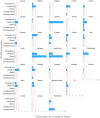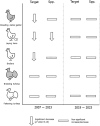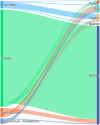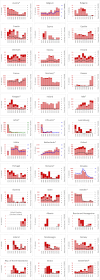The European Union One Health 2023 Zoonoses report
- PMID: 39659847
- PMCID: PMC11629028
- DOI: 10.2903/j.efsa.2024.9106
The European Union One Health 2023 Zoonoses report
Abstract
This report by the European Food Safety Authority and the European Centre for Disease Prevention and Control presents the results of zoonoses monitoring and surveillance activities carried out in 2023 in 27 Member States (MSs), the United Kingdom (Northern Ireland) and 10 non-MSs. Key statistics on zoonoses and zoonotic agents in humans, food, animals and feed are provided and interpreted historically. In 2023, the first and second most reported zoonoses in humans were campylobacteriosis and salmonellosis, respectively. For both agents, an increase in the absolute number of cases was observed in comparison with 2022. Fifteen MSs and the United Kingdom (Northern Ireland) reached all the established targets in poultry populations with regard to the reduction in Salmonella prevalence for the relevant serovars. Salmonella samples from carcases of various animal species, and samples for Campylobacter quantification from broiler carcases, were more frequently positive when performed by the competent authorities than when own-checks were conducted. Shiga toxin-producing Escherichia coli (STEC) was the third most reported zoonotic agent in humans, followed by Yersinia enterocolitica and Listeria monocytogenes. L. monocytogenes and West Nile virus infections were the most severe zoonotic diseases, with the highest percentage of hospitalisations among cases and the highest case fatality rates. Twenty-seven MSs and the United Kingdom (Northern Ireland) reported a slight decrease in food-borne outbreaks in 2023 overall in comparison with 2022, although the overall number of reported human cases and hospitalisations increased. Salmonella Enteritidis remained the most frequently reported causative agent for reported cases and food-borne outbreaks. Salmonella in 'eggs and egg products' was the agent/food pair of most concern. In 2023 this combination caused the largest number of outbreaks and cases among all agent/food combination and ranked second in number of hospitalisations. Salmonella was also the causative agent associated with the majority of multi-country outbreaks reported in the EU in 2023. This report also provides updates on brucellosis, echinococcosis, Q fever, rabies, toxoplasmosis, trichinellosis, tuberculosis due to Mycobacterium bovis or M. caprae, and tularaemia.
Keywords: Campylobacter; Listeria; Salmonella; West Nile; food‐borne outbreaks; monitoring; parasites; zoonoses.
© 2024 European Food Safety Authority. EFSA Journal published by Wiley‐VCH GmbH on behalf of European Food Safety Authority.
Figures































References
-
- About, F. , Pastre, T. , Boutrou, M. , Martinez, A. Y. , Melzani, A. , Peugny, S. , Michaud, C. , Zouaoui, S. , Carage, T. , Rose, V. S. , Demar, M. , Lavigne, J. P. , Djossou, F. , O'Callaghan, D. , Epelboin, L. , & Keriel, A. (2023). Novel species of Brucella causing human Brucellosis, French Guiana. Emerging Infectious Diseases, 29(2), 333–340. 10.3201/eid2902.220725 - DOI - PMC - PubMed
-
- Alban, L. , Pozio, E. , Boes, J. , Boireau, P. , Boué, F. , Claes, M. , Cook, A. J. , Dorny, P. , Enemark, H. L. , van der Giessen, J. , Hunt, K. R. , Howell, M. , Kirjusina, M. , Nöckler, K. , Rossi, P. , Smith, G. C. , Snow, L. , Taylor, M. A. , Theodoropoulos, G. , … Zimmer, I. A. (2011). Towards a standardised surveillance for Trichinella in the European Union. Preventive Veterinary Medicine, 99(2–4), 148–160. - PubMed
-
- Alessiani, A. , Di Domenico, M. , Averaimo, D. , Pompilii, C. , Rulli, M. , Cocco, A. , Lomellini, L. , Coccaro, A. , Cantelmi, M. C. , Merola, C. , Tieri, E. E. , Romeo, G. , Secondini, B. , Marfoglia, C. , Di Teodoro, G. , & Petrini, A. (2024). Coxiella burnetii: A brief summary of the last five years of its presence in the Abruzzo and Molise regions in Italy. Animals, 14(15), 2248. 10.3390/ani14152248 - DOI - PMC - PubMed
LinkOut - more resources
Full Text Sources
